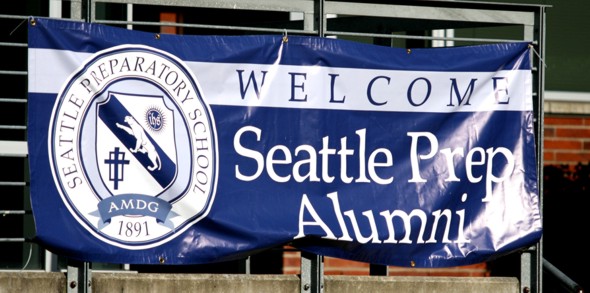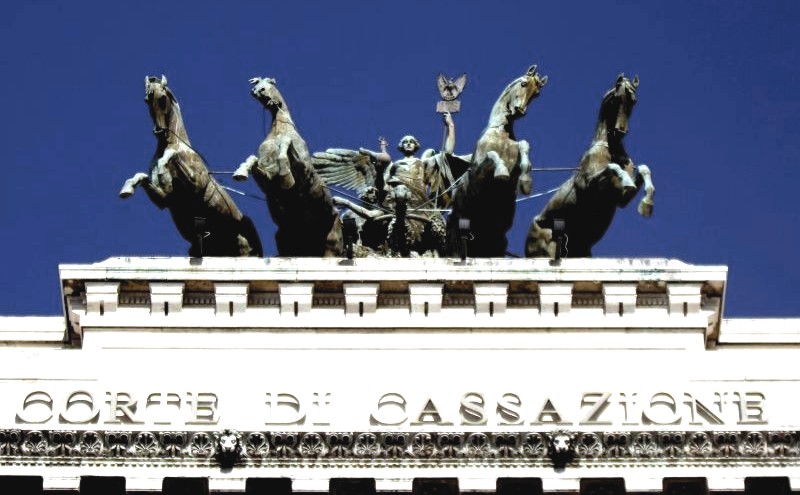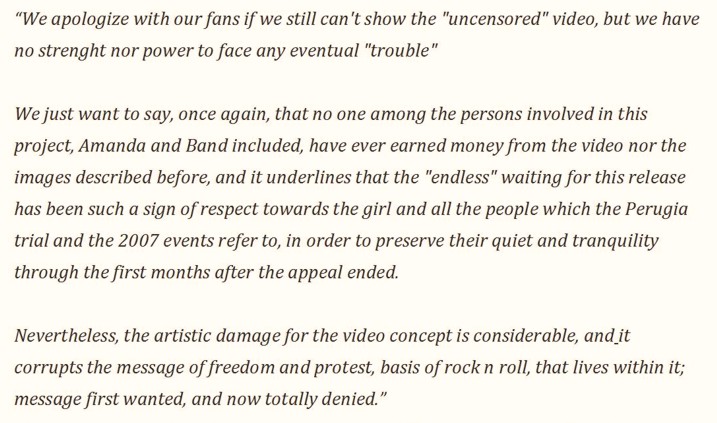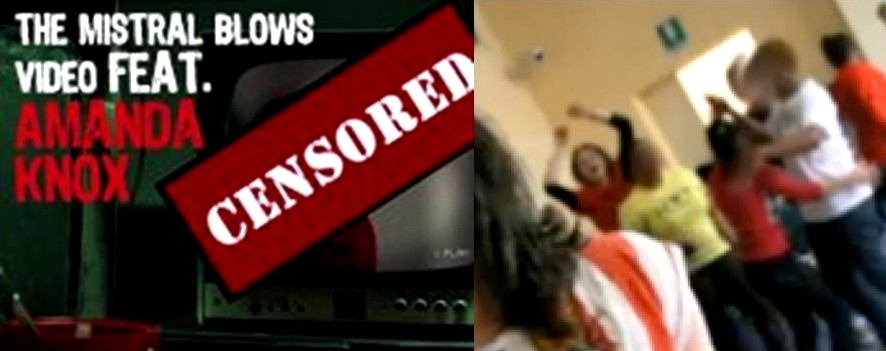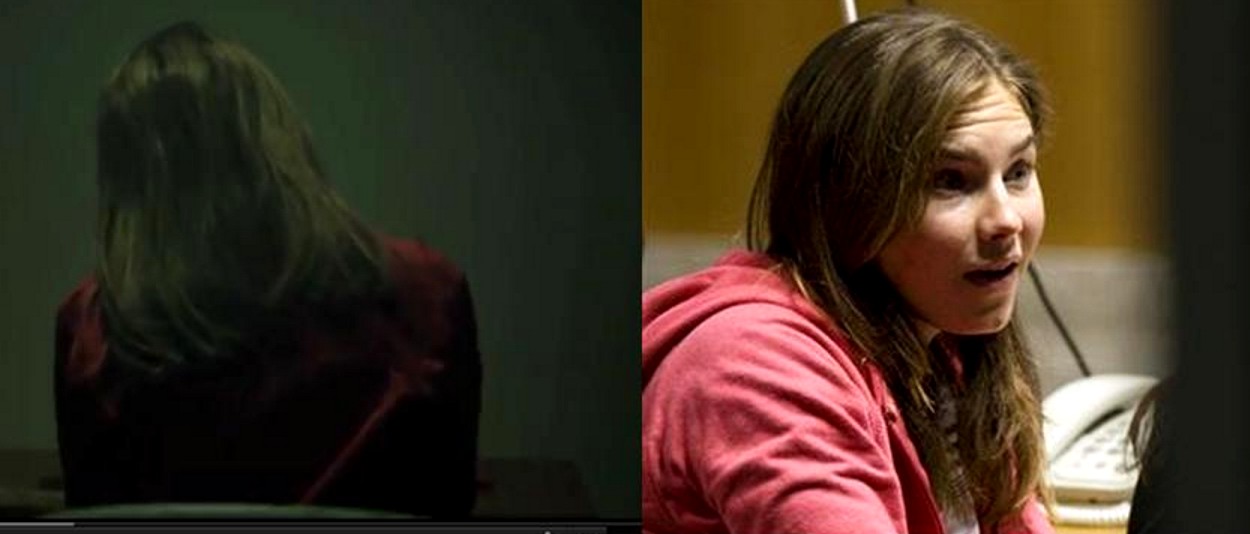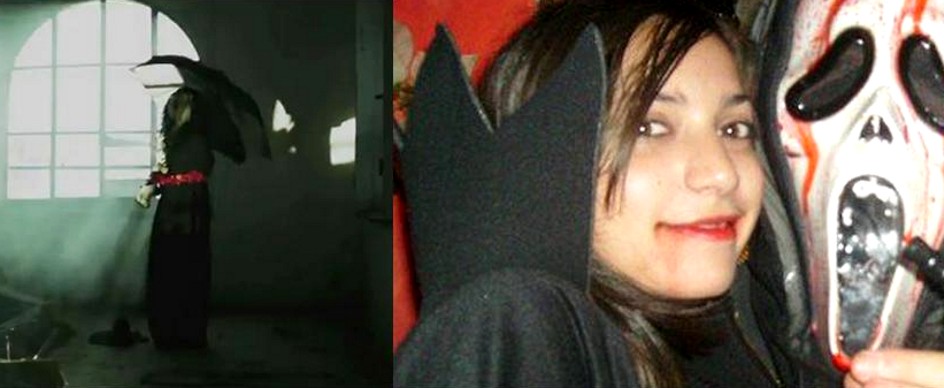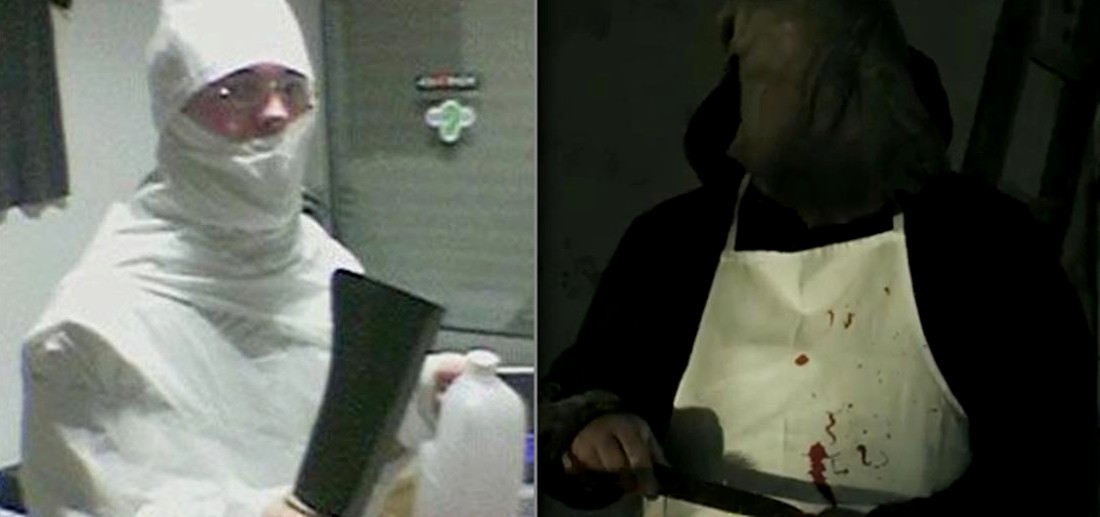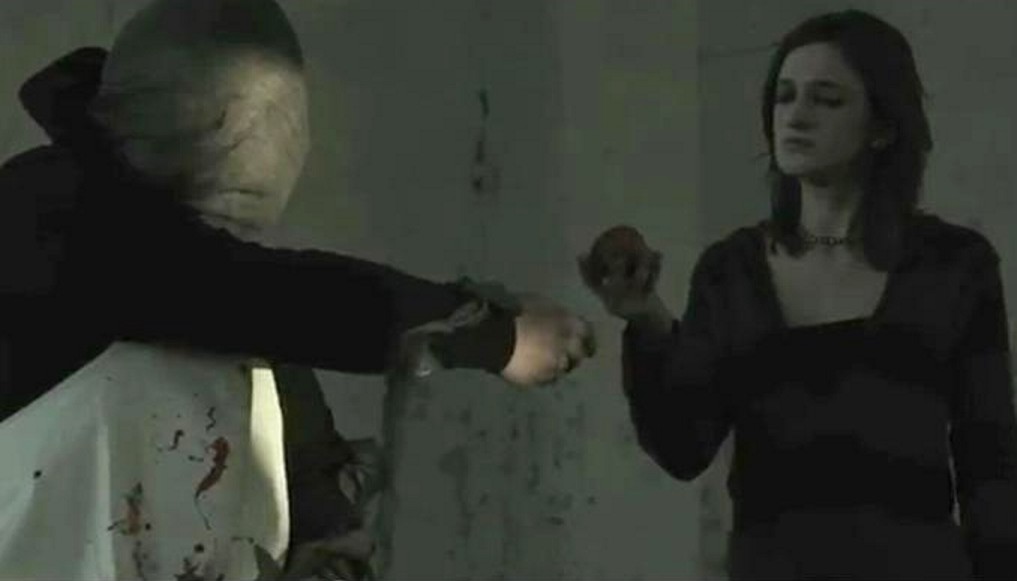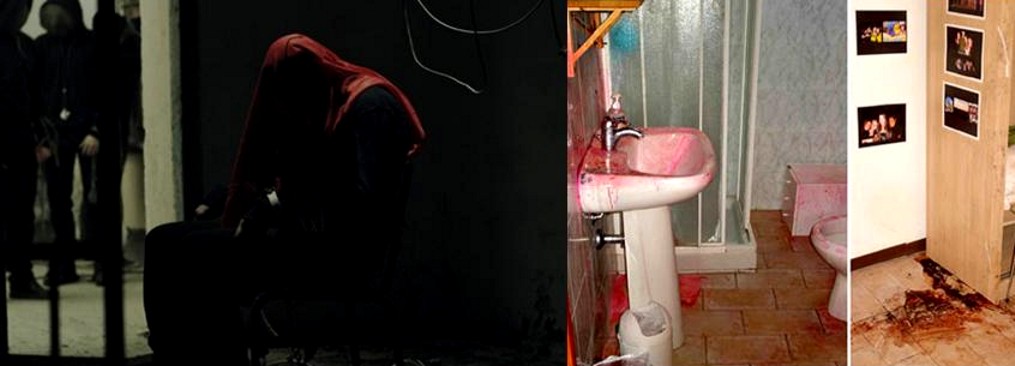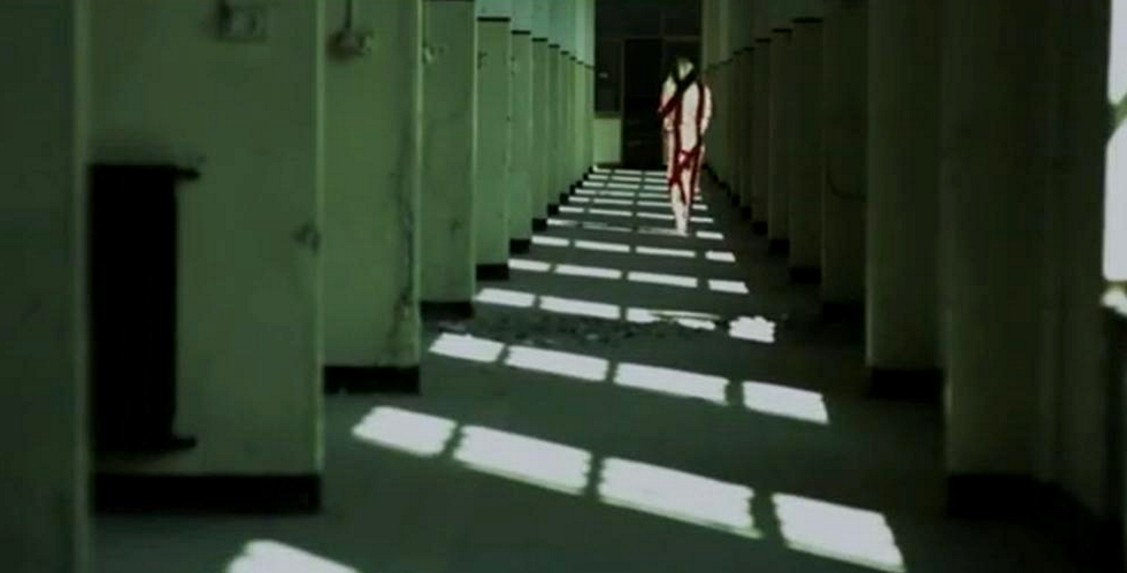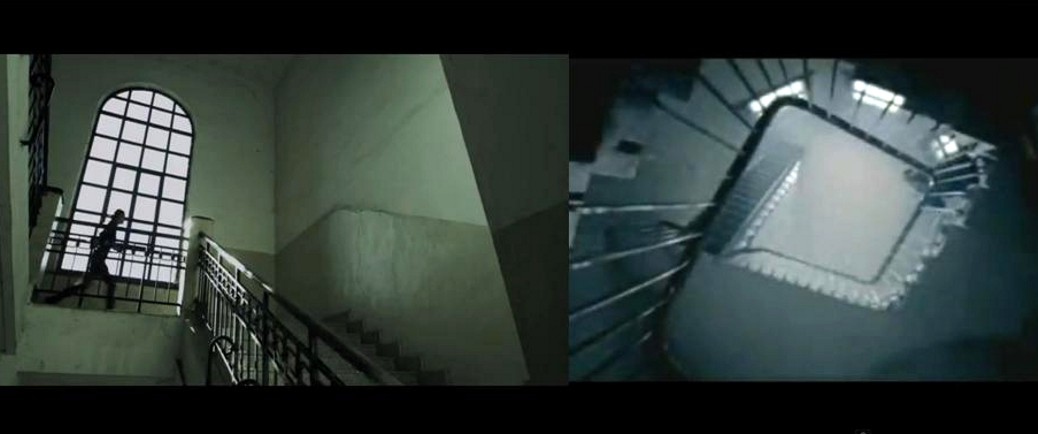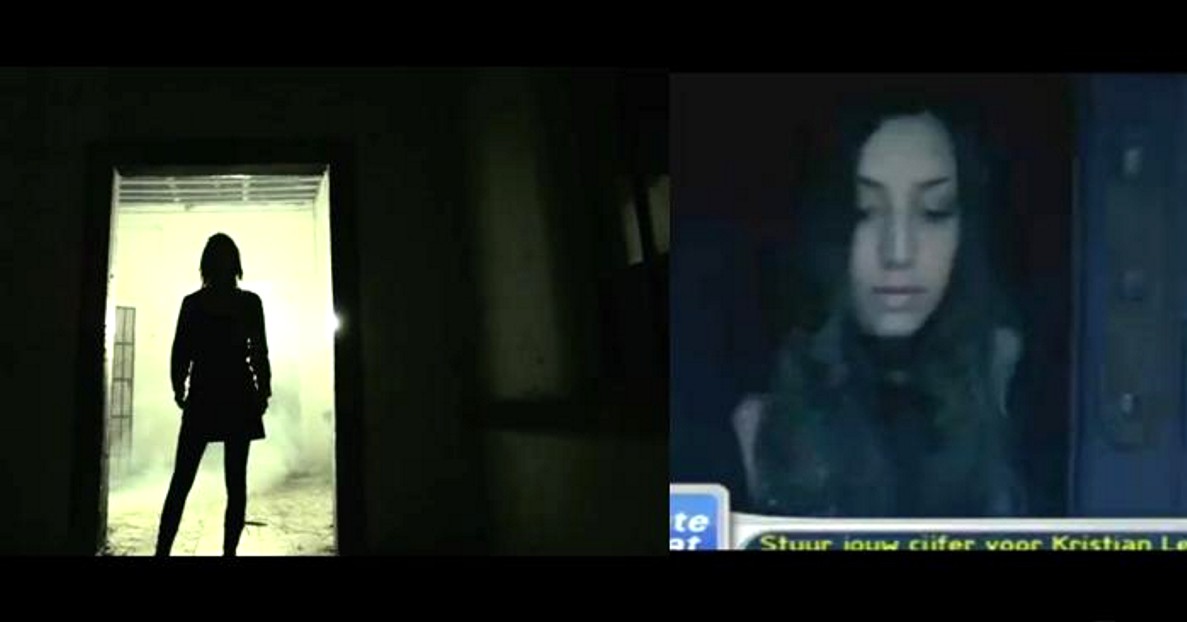
Category: Amanda Knox
Tuesday, April 02, 2013
A Growing Number Of Commentators Are Objecting To Overexposure Of The Two Still Accused
Posted by Peter Quennell

We have a series of posts coming up that will describe in detail and analyze the outcome of the Supreme Court.
At least one post will be a roundup of the media. Noticeable this time was less of a tendency to lionize Knox and Sollecito. Some articles and TV reports flipped for Knox, but none did for Sollecito.
And some editors and reporters have weighed in strongly for better balance. David Barrett of the Daily Telegraph wrote this one.
The impending retrial for the murder of British student Meredith Kercher fills many court-watchers with dread, myself included.
Details of the crime are horrific enough. But during the lengthy court processes which we have already witnessed, my discomfort was intensified by the obsession with Amanda Knox.
The photogenic young American, now 25, was convicted and then acquitted of the 2007 murder. She received more sympathy than most suspects who have ever stood in the dock on such a serious charge.
The media pack which followed the Italian trial would often comment on Knox’s apparent frailty; the “stress” she was suffering or whether she looked “pale”. It made me gag.
It’s a difficulty with which any professional and humane court reporter is familiar: how do you keep the victim, who is absent, visible in the very human drama that is a murder trial?
Is it appropriate to pay more attention to the suspect than to the issue at hand; namely, securing justice on behalf of a person whose life has been taken from them? I say it is not, although I can understand why it happens….
When the Italian prosecutors again attempt to secure a conviction for that tragic murder in Perugia we will have to get used to seeing Knox’s face on a daily basis once more. But let’s ensure that Meredith remains at forefront of all our minds.
.
Wednesday, February 06, 2013
Should The Knox Defense Point The Finger At An Angry Daddy?
Posted by Our Main Posters
1. State Of Judicial Process
Given a level playing field (a big if) it seems for now that Amanda Knox and Raffaele Sollecito are almost certainly going down for the final count.
There is not the slightest sign that their defense lawyers know how to contend with the Supreme Court appeal filed by Umbria’s chief prosecutor Dr Galati. One may have already walked (Maori) and the fact that the others don’t respond publicly to the Galati filing speaks volumes to Italian lawyers.
If the first appeal (called in Italy the second level) is rerun in whole or in part, Sollecito and Knox could see Judge Massei’s “mitigating factors” annulled and find themselves each facing 30 years inside or even life.
The whole thrust of Sollecito’s ill-timed book (subtitle “how to shoot oneself in both feet”) is that he deserves to serve less time than Amanda Knox (who he “nobly saved”) and preferably to serve no time at all.
2. Sliding Scales Of Discussions
Many bright people follow the case. We have many lawyers and crime experts and even judges read here. Many took a long time to settle on a “guilt” point of view and approached it very professionally (reflected in many of the posts written by professionals here). This is contrary to the klutzy, amateurish FOA campaign and their inaccurate rants about “haters”.
There are various great sliding scales or continuums in considering all aspects of this case. A lot of what we talk about on PMF and TJMK is where, precisely, we should all come down on each of these various scales at the end of the day. Especially of course how the judges in Rome and Perugia should calibrate them.
Via Dr Galati’s appeal and especially Sollecito’s book, we now have a new one. If reconvicted, should Sollecito and Knox serve equal time? Or should one or other serve more? Let us approach this by considering first some of the most-discussed of the sliding scales.
1) Was Knox a good friend of Meredith or increasingly a pariah?
Many here incline strongly to pariah.
Knox has an obvious tin ear and sharp elbows, was doing little study in Perugia, was making life hell for all her flatmates, was bringing noisy threatening lowlife men home (the other three virtually never brought men home), was disturbing Meredith’s studies, was hitting on patrons in Patrick’s bar, and was definitely into drugs to the extent that she might already have become an addict.
2) Pre-meditated murder or a hazing or spontaneous spiral initiated by Guede?
At least some here incline to the view espoused by some psychologists that Knox and Sollecito were probably both at minimum fantasizing violence, Knox against Meredith, and Sollecito long-term generically.
Knox had become threatened by Meredith in several different ways: Meredith was prettier, was much funnier, had won the best available boy, was brighter, had a tougher study regime, was more directed and ambitious, and had left Knox in the dust on all fronts. Hints that Meredith was about to get Knox’s job at Patrick’s bar could have been the last straw.
To most here, Knox has always seemed the initiator and the leader in the rage against Meredith, and the other two were possibly drawn in by group dynamics.
Judge Micheli certainly believed this. Judge Massei might have done, and his pointing at Guede (espoused in spades by Hellmann and Zanetti) and Massei’s “mitigating factors” both seemed “humane” stretches to give them a few years off - stretches which Chief Prosecutor Galati in his appeal and the Supreme Court in their finding on Guede have already both rejected.
3) Isolated crime/unique family or does American society incline this way?
Statistics show that society here in the US is separated out between super-rich and the other 99% more than at any time in the past 80 years and although productivity has been going up amazingly, all fruits of growth have gone to those super-rich. Many of them have a mindset that basically tells them they made it on their own, and government roles in their success and that of their creative hard-working employees dont matter a damn.
The situation and the anger in the US has been worsening, and absence of true growth for most people also have European and Japanese societies in disarray
In the US one can see heightened levels of anger in the losers of the Superbowl, in the renewed buying of guns, in conspiracy theories on the Internet, in the success of the very thought-provoking Hunger Games books and movie (small people against rich and a captured, cruel over-militarized government), in politics (of course!), and in the vitriolic flames on the IMDB movie forums now against the front-runner movies and actors for the Oscars.
We may not see this at major play here in the crime against Meredith, though, except in the over-competition sense, and the sense that Knox grew up in slight poverty (see below) and was burning through her savings with all the cocaine use (Perugia cops think it was cocaine)
4) Mental ill health in the perps and/or families or original evil?
Sollecito’s dad has long admitted that Raffaele is not normal, and he has struggled to keep him off drugs and focussed hard on his studies. His dad also admitted to all Italy that Sollecito included defamatory lies in his book.
An open and shut case? Seems so. Raffaele now looks “uncomplicatedly” psychopathic and the myriad wrong and nasty claims in his chest-beating book really hammer this take on him home.
That book seems to be his equivalent of Knox’s abrasive, uncaring two days on the stand in 2009 which so damaged her with the Massei jury.
Knox’s mental health seems more complicated. She was widely known to be “quirky” as a kid and then she became pretty wild in Seattle after she moved to live near the university. That certainly wouldn’t have helped.
Most recently, Knox seems to be sliding away into a bubble world without any possibility of admitting she needs treatment, which seems to explain her being kept well out of sight for a year now and not working or studying.
Generally the PROSECUTION in Perugia has been the side to suggest she is not mentally fully well (after the psychological tests in Capanne Prison in 2008) and the DEFENSE and FAMILY has been the side that shrugs this off and hasn’t made it any part of her defence.
Knox seems to have given off plenty of signs in the days after Meredith died that she was alternating between glee and horror. So she seemingly did know what she was doing on the night, and our guess is that it was she who pushed the knife in. In these circumstances the original verdict and sentence seem appropriate.
However!
5) Knox made herself what she was or did her family contribute?
Curt Knox’s seeming blind rage at Edda during their marriage and for years after are an open secret among some in Seattle. He apparently had one of the worst records in the entire US in not paying child support to Edda for Amanda and Deanna, and had again and again to be taken to Superior Court by Edda to be forced to make his monthly payments.
Here are two public records showing two instances of him being taken to Superior Court by Edda.
And we are told that Curt Knox was counseled by one or more judges to get himself some anger management therapy. Apparently he wasn’t formally required to take anger management therapy. He may have done so, though there seems no record that he ever did.
Okay. Not all kids growing up in such toxic family situations suffer, but some do, and a few end up with their hard wiring seriously messed up. Some even end up as drug-takers and murderers.
The classic example recently was the mass killer Anders Breivek in Norway, whose early childhood in a toxic family situation was not entirely unlike Knox’s. (In that case also, the prosecution thought maybe he was nuts, and the defense, successfully, argued otherwise.)
Italian lawyers tell us that it would be for the DEFENSE to bring this up in Perugia if it is a possible mitigating factor, and that it doesnt impinge on the prosecution’s case.
But how could they?
Curt Knox was apparently the one who shushed Amanda Knox at their first meeting in Capanne Prison, Curt Knox was apparently the one who misled her about the world-wide skepticisim against her (she didnt know about that until she came out of prison), and Curt Knox was apparently the one who drove the nasty PR bus - and most recently hosted all of the worst of the rabid PR nuts (including Sforza and Fischer) in Seattle.
Curt Knox has apparently consistently instructed the defense lawyers and PR honchos to keep the pedal to the floor, even though Chris Mellas once openly argued against that. Amanda Knox may have pushed the knife in, but Curt Knox for five years has not come clean about his own possible role in any mental condition.
Our present conclusion
Without a lot more information on Amanda Knox’s early days in her broken home in Seattle, and her current mental condition and condition back in 2007, it is pretty hard to calibrate this. It is not really possible to be precise about where she should be on any sliding scale of time deserved in prison if she is finally convicted.
It is really incumbent upon the defense counsel in Italy (their lawyers’ code of ethics requires this) to push hard for this information, and if they think it relevant to present it to court at any rerun of the appeal trial.
Amanda Knox herself should want this.
Saturday, November 17, 2012
Fervent Knox Supporter Tom Wright Seemingly Strongarms Knox High School Into “Honoring” Her
Posted by brmull
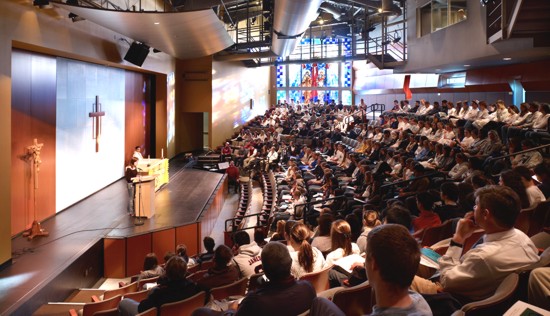
One thing is for sure. Not many schools - maybe none, ever - have accepted the creation of a scholarship to honor a convicted felon who, until the Supreme Court signs off, still stands accused of a very cruel crime.
Seattle Preparatory School is a fee-paying Jesuit Catholic school about a mile north of Seattle downtown, on the south side of Portage Bay from the main campus of the University of Washington. See Google Earth image at bottom. The school’s student role is estimated at around 650.
This announcement of a new scholarship in the name of Amanda Knox was recently published: “The fund, established by past parent [and co-founder of the advocacy group Friends of Amanda Knox] Tom Wright, will provide tuition assistance to students in need.”
Early in 2011 Tom Wright [seen reading a statement in a black shirt below] presided over a seriously loopy panel presentation at Seattle University, attended by a sparse crowd of about 35, which garbled all the hard evidence in the case and accused Italian officialdom of a number of crimes. See for example our reports here and here.

Tom Wright apparently had to kick in at least $50,000 for initial fund of the endowment, and he hopes that others will feel impelled to contribute as well.
For him this is certainly a labor of passion, since Knox with her book advance has more than enough resources of her own to set up an endowment if she wished, though to date we have seen no indication that Knox has made any charitable donations. Tom Wright seeks to make it look noble.
Sara [his daughter] and Amanda were good friends at Prep… With this fund our family wants to honor the courage of Amanda and her family. They displayed great dignity and fortitude enduring a wrongful prosecution on foreign soil. During years of unjust incarceration, the school supported Amanda through prayers and letters of support. Prep acted in the Jesuit spirit by seeking social justice and helped to win a fight worth remembering.
According to the announcement applicants should demonstrate the same “moral courage, strength of character under duress and a sincere desire to help others in need” that was supposedly exhibited by Amanda Knox.
Claims of “wrongful prosecution” and “years of unjust incarceration” are way premature, and contradicted by all these posts here.
“Moral courage” means taking a risk in order to do what one believes is right. Put aside for a moment the overwhelming evidence that Knox did murder Meredith Kercher. To what instance of moral courage could the school possibly have been referring? We don’t have a clue.
“Strength of character under duress” is pretty much expected of any upstanding member of society. But if there’s one person to which it surely doesn’t apply, it’s someone who was convicted of falsely accusing her kind boss of murder and wrecking his business. Billions of people have a “sincere desire to help others in need.” What makes Knox notable here?
Why else might Knox have been deserving of a scholarship in her name? It’s often said that she was an “honor student” but we wonder why she wasn’t wearing any honor cords at her graduation while other students had them. Author and Knox innocence proponent Nina Burleigh wrote that she “almost flunked” a religion class and was made to take summer school.
Knox has also been described as a “star soccer player.” The team she played for, however, endured “four bleak, losing seasons” according to Nina Burleigh’s book.
A few teachers and students spoke up rather listlessly and doubtfully for Knox after she was arrested and put on trial. Several are believed to have said that they were really not too surprised to hear of the mess she was in.

;Above: school president Dr Kent Hickey]
Is there ANY solid reason in the public record why Knox is deserving of this singular honor?
Tom Wright seems to have been motivated above all by his desire to memorialize “a fight worth remembering.” As much as anything else, that fight consisted of himself and a small group of like-minded diehard parents appropriating the school’s good name and resources for the purpose of a nasty, bigoted, defamatory, strong-arming campaign which played fast and loose with the facts.
Dr Kent Hickey [image directly above] became president of Seattle Prep two years after Knox graduated. He didn’t know her at all, and he may not even have met her face to face before the school accepted a scholarship in her name. Nonetheless, he described her to the media as “a good and thoughtful girl”.
He defended the school’s decision to raise funds for her by saying “We can’t pick and choose the graduates we help.” Yet Seattle Prep DOES indeed pick and choose, all the time. The school routinely punishes and expels students for everything from minor insolence to felonies. We can’t find any other instance in which it has held fundraisers for any alum—let alone a convicted felon—despite 8,000 alums living in the Seattle area.
And so Seattle Prep parents and onlookers might be forgiven for thinking that Dr Hickey is grasping at straws to justify his school’s very strange action.
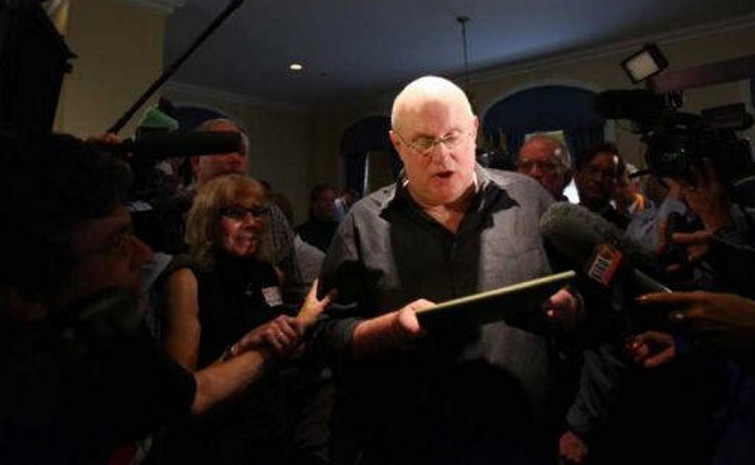
[Above: scholarship creator Tom Wright]
One angered parent commented on the PR campaign as follows in an excellent investigative report by James Ross Gardner in the local magazine Seattle Met late in 2010:
It is true some of the Seattle Prep families have allowed their students to support Amanda Knox. I do not believe that it is a 100%. A number of families have felt their students were pressured into supporting Knox without having a choice. That is not the Seattle Prep I knew from my years there as a student, nor is it what my husband experienced.
In our years as Prep students we were allowed choice rather than pressure. Because of the pressure, a number of family are not making their annual donations to Seattle Prep. I, for one, will be glad when the verdict in the appeal is handed down so perhaps we can all move past this event. Yes, event.
Seattle Prep has made it into an event and it takes away from the students discussing other news and issues. I do not wish Knox ill but my children did not go to school with her and do not know her. They have no idea if she is guilty. They are more worried about their close friend that is fighting cancer. It is time to un-focus on Knox. That’s just my opinion.

An angered alum of Seattle Prep offered this opinion to the reporter from Seattle Met:
I went to Seattle Prep, and did a full year in Italy. I learned Italian and the culture and saw a lot of Americans and Italians from the South that studied in Central and Northern university towns go a little nuts with all the freedom away from home.
Since I started following this trial, I could totally see how immoral behavior could lead to Amanda doing what she was accused of doing. Drug use, jealous roommates, and illicit sex are not a good mix, especially when people need money to support such habits. Amanda seems to have a lobby of easily-swayed-by-propaganda lab rats who bought in to the PR agency story and don’t bother following the case in its entirety.
I do not know the background of the Seattle Prep Principal, but I think he is getting in way over his head by getting into this case, and as a prior poster mentioned, he is putting a lot of pressure on people to get on the pro-Amanda bandwagon. So sick to sway young students’ minds on what to think.
This sounds like our post-modern decaying American mentality of choosing sides and voicing misdirected-emotions in forming opinions. The Principal does not sound like a well educated, worldly individual to put the Academic Institution and its students, employees and graduates in the middle of this fiasco. It reeks of “We Support Our Troops,” military campaigns to coerce and intimidate people into believing in a “popular” movement.
It’s a cruel joke that needy students who are not in a position to turn down financial aid will be forced to associate themselves with Amanda Knox and an ignominious campaign of bigotry, defamation and intimidation.
It is to them and the real victims, Meredith and her family, that Seattle hearts should go out.
Tuesday, September 25, 2012
Will Sollecito Drop Amanda Knox In It Further In A Public Seattle Interview At 7:00 PM Tonight?
Posted by Peter Quennell

This is Kane Hall on the University of Washington campus where at 7:00 tonight Sollecito is set to be interviewed.
What was described in this excellent series by an Italian lawyer on four of the Porta a Porta shows continues to be the case. One perp slyly pushing another toward the fire, in an attempt to protect his own sorry ass.
On two levels the woolly-brained component of the Seattle media and the woolly-brained Knox-Mellas camp seem to have only the dimmest comprehension of the slow-motion train-wreck Sollecito has managed to create.
(1) Sollecito may continue to claim that he “saved” Amanda by standing by her when others urged not to, but as future posts here will show, he provably didnt, and in his book in a number of places he includes very incriminatory points about her.
(2) Provable lies in Sollecito’s book have already stirred up a hornet’s nest in Italy and his own father and his lawyers have backed off - right when RS and AK face one of the toughest appeals our Italian lawyers have ever seen.
Can Sollecito be expected to make things worse both for Amanda and for himself tonight? It may not be obvious to much of the audience, but our own bet is: for sure. Must-read posts in advance here and here and here.
And a must-read book. That narcissistic killer flaunted the system - and is now doing 33 years.
Monday, August 20, 2012
Dissecting The Hellmann Report #4: The Contortions To Dismiss Witness Quintavalle
Posted by Cardiol MD

[Above: Images of Mr Quintavalle’s Conad store; he serves at far left, his cashier serves at far right]
Scroll down here for previous posts in this series.
Mr Quintavalle owns the Conad franchise at the lower end of Via Garibaldli, about halfway between Meredith’s place and Sollecito’s. Judge Massei in his trial sentencing report had stated this about Mr Quintavalle on page 83:
This Court deems that the testimony of Quintavalle is reliable. It was discovered that Inspector Volturno did not ask Quintavalle if, on the morning of November 2, he saw Amanda Knox in his shop.
He was asked ““ so Quintavalle recalled - about purchases made by Raffaele Sollecito. Mr. Quintavalle did not say anything about having seen Amanda Knox on the morning of November 2, 2007 in his shop because he was not questioned about this and because, as indicated by Quintavalle himself, he considered this fact to be insignificant.
This post exemplifies how the Hellmann-Zanetti web of deception uses a flood of reasons-to-doubt in its attempt to discredit Massei’s conclusion that Quintavalle was a reliable witness. Remarkably, the judges did not even recall Mr Mr Quintavalle, and mostly they work from the brief summary of his testimony in Massei’s report and little else.
Quintavalle’s testimony is key to the guilty verdicts against Knox and Sollecito, and contrary to Hellmann-Zanetti’s improper purpose; therefore they proceeded to systematically “disprove” Massei’s conclusion, stating this on page 39:
Indeed, Quintavalle asserts that she left without having purchased anything.
Verbatim from the hearing of March 21, 2009:
The Hellmann report here proceeds to selectively quote the hearing-transcript in a manner contrary to the usual and customary English-language meaning of “verbatim”. It may be that Hellmann-Zanetti meant to indicate that only the words they did quote were verbatim, and that their ellipses indicated innocent omissions. However the effect of their omissions is not innocent.
“¦If they had asked me”¦also because, I repeat, I, when the young lady came into my store, I did not see her leave with anything, because when she passed by and passed by again, when she left and I saw her, out of the corner of my eye I saw her leaving, I did not see that she had a shopping bag or anything in her hands.
PRESIDING JUDGE [PRESIDENTE]: You are speaking of the morning of November 2?
ANSWER: The morning of November 2. I don’t know if she bought anything, I don’t know. My cashier doesn’t remember if she bought anything, I am not able to say whether she bought something or not”¦”
If one wanted to maintain that perhaps Quintavalle is wrong, because she actually did purchase something, it would be correct to observe that if he could be wrong on this point, and also about the clothing she was wearing, then he could also be wrong about the identification of the young woman [giovane] as Amanda Knox.
Finally, the testimony of the witness Quintavalle does not seem reliable, and, in any case, represents an extremely weak piece of circumstantial evidence.”
Examples of Hellmann-/Zanetti’s flood of Reasons-to-Doubt [That AK/RS are Guilty] :
From Hellmann-Zanetti pages 39-43:
“Quintavalle
Another piece of evidence [uno degli elementi] on which the Court of first instance based its conviction of guilt is represented by the testimony of the witness Quintavalle, owner of a grocery store in Corso Garibaldi, not far from Sollecito’s house but also just a few minutes from via della Pergola: he in fact asserted that he saw, early in the morning of November 2, a young woman enter[sic] his store after having waited for it to open, whom he later recognized as Amanda Knox.
According to the prosecution (and to the Court of first instance), this circumstance proves that, contrary to the alibi she gave, she did not sleep at Sollecito’s house until late in the morning, but went very early to Quintavalle’s store, as she urgently needed to acquire a cleaning product suitable to clean the house in via della Pergola of her own traces and those of Raffaele Sollecito, before the police could intervene and take samples, since it was inevitable that sooner or later the alarm would be given because of what had happened.
In reality, even under the assumption that the circumstance is true, this would be a weak piece of circumstantial evidence, incapable in itself of proving guilt even presumptively; but in any case this Court holds that the testimony of the witness is not very reliable, in particular in what concerns the identification of the early”morning client with Amanda Knox.”
(1) Reason-to-Doubt #1: “”¦INCAPABLE IN ITSELF of PROVING guilt even presumptively”¦.”
The reader is being steered away from a level of doubt that is beyond-reasonable, and towards the territory of reasonable-doubt-that -AK/RS-are-Guilty.
“INCAPABLE IN ITSELF” improperly isolates the issue from all the other considerations which should simultaneously-be-taken-into-account.
“PROVING” improperly implies an inappropriate standard of “˜certainty’.
“¦.this Court holds that the testimony of the witness is NOT VERY RELIABLE, in particular in what concerns the identification of the early”morning client with Amanda Knox.
Logically “not very reliable” does not exclude “reliable” but Hellmann-Zanetti presumably don’t intend to concede that Quintavalle is reliable; this betrays Hellmann-Zanetti’s extreme bias and determination to exclude Quintavalle’s damning identification of [their client?] Knox.
Later on page 38:
In fact, he presented himself to the police only a year later, following intense urging by a young apprentice journalist”¦..”
This is a misleading reference to Antioca Fois; see Massei page 84:
He later spoke about having seen Amanda Knox because a young man who used to live above his shop, who he knew, Antioco Fois, had just graduated and had become a freelance reporter for the newspaper Giornale dell’Umbria. When he passed him, he would sometimes ask: “But do you know anything? Did you see something? Did you hear something?”
So one day Quintavalle told Fois that he had seen Amanda Knox on the morning of November 2; later he decided to go to the Public Prosecutor’s Office because Antioco Fois convinced him that this fact might be important.
So the “intense urging” was more like friendly exchanges with Quintavalle’s neighbour, a former lodger.
(2) Reason-to-Doubt #2: “In fact, he presented himself to the police only a year later”¦.”
Readers are invited to mistrust Quintavalle because he belatedly told this to the police for an untrustworthy reason, steering them further away from a level of doubt [with regard to Knox/Sollecito guilt] that is beyond-reasonable, and further into territory that is reasonable-doubt of their guilt.
Later still on page 38:
Now, what actually happened more than a year before Quintavalle presented himself to the police is absolutely not irrelevant, for the purpose of evaluating the reliability of the witness, especially from the point of view of the genuineness of his memories and the exactness of the identification.
(3) Reason-to-Doubt #3: “absolutely not irrelevant, for the purpose of evaluating the reliability of the witness”
This double-negative statement further invites Readers to regard Quintavalle as unreliable because his memories are false, and his identification of Knox is too inexact. Steering Readers yet further into a level of doubt of Knox’s guilt that is reasonable-doubt.
Yet further down on page 38:
“¦..this was a witness who ““ taking into account what he himself explained ““ took a year to convince himself of the precision of his perception, and the exactness of the identification of Amanda Knox with the girl that he saw, although he was able to appreciate the relevance of his testimony already in the days immediately following the murder.
(4) Reason-to-Doubt #4: “..took a year to convince himself…”
From Hellmann-Zanetti page 36:
“¦..took a year to convince himself of the precision of his perception, and the exactness of the identification of Amanda Knox with the girl that he saw, although he was able to appreciate the relevance of his testimony already in the days immediately following the murder.
Repetition of reader-invitation to regard Quintavalle as unreliable, because his perceptions are not precise enough for Hellmann-Zanetti, and his identification of Knox was too inexact even though he knew at that time that his testimony was crucially relevant.
The reader is being steered even further away from belief that Knox and Sollecito are guilty towards the territory of reasonable-doubt-that -AK/RS-are-Guilty.
Are we there yet? Is there reasonable-doubt-that-AK/RS-are-guilty NOW?!
(5) Reason-to-Doubt #5: “Quintavalle cannot maintain that…”
Near the bottom of Hellmann-Zanetti page 38:
...from the testimony of Inspector Volturno at the hearing of March 13, 2009, it turned out that Quintavalle and his employees and other shopkeepers in the area were shown photographs of Raffaele Sollecito and Amanda Knox, and were asked in particular to mention any possible purchases of cleaning products on the part of the couple, as this was a precise focal point of the investigation. Thus, Quintavalle cannot maintain that he did not mention what he saw on the morning of November 2 to Inspector [53] Volturno because he did not think it was a relevant circumstance.
Readers are yet further invited to mistrust Quintavalle, because his failure to “mention” everything he had seen, and his idea of “a relevant circumstance” were unacceptable to Hellmann-Zanetti.
That’s already five reasons to doubt on the first Quintavalle page alone.
See also Hellmann-Zanetti page 42:
....according to Quintavalle’s own statements ““ he only caught a glimpse of the girl, first out of the “corner of his eye” and then from a bit nearer for a few moments, but never from the front (verbatim from the hearing of March 21, 2009: “Yes, then she entered, I saw her let’s say like this, three quarters left, three quarters of the left side. I didn’t see her from the front”¦”
And Hellmann-Zanetti page 43:
“....when she left and I saw her, out of the corner of my eye I saw her leaving,”
Hellmann-Zanetti are now reduced to semantic quibbles about Quintavalle’s use of words to describe his visual-angle-of-view when he looked at Amanda Knox’s face.
But see Massei page 83:
This young woman remained impressed in his memory because of her very light coloured eyes, azzurri [light blue]. “¦. she could have been 1.65 to 1.67metres tall. Her face was bianchissimo [very light skin colour] and she apparently was about 20-21 years old.
And see Massei page 84:
...it is worth observing that the witness gave a precise description of what he saw on the morning of November 2 and also provided a description of certain physical features of the woman he saw (light blue eyes and pale face) which, together with the unusual time, may well have fixed in his memory what Quintavalle said he saw.
So by selective omissions of the contents of the Massei Report, based on the 4-dimensional observations of the Massei trial hearings, Hellmann-Zanetti use a 2-dimensional record of the Massei Proceedings, and semantic quibbles about Quintavalle’s angles of visual observation, to discredit Quintavalle’s testimony.
Even though Quintavalle - who the Hellmann-Zanetti jury never even saw - had testified convincingly at trial that it was Amanda whom he saw in his shop at opening-time on November 2, 2007, and he had held up well under cross-examination.
Enough already? Isn’t this a contorted flood of Reasons-to-Doubt-That-AK/RS-are-Guilty? Do you now believe that Quintaville is an unreliable witness?
If you now believe that Quintaville is unreliable, then Hellmann-Zanetti will have accomplished their mission.
[Below: Conad is at right and School for Foreigners at back. RS’s place maybe 500 meters behind, up the hill]
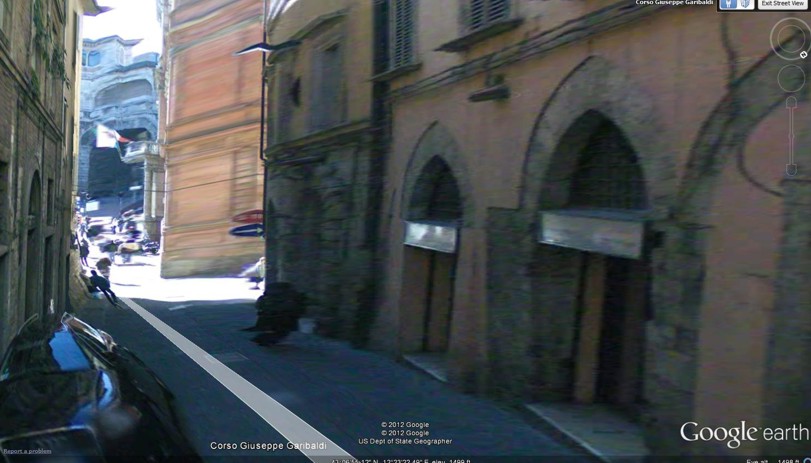
Thursday, August 16, 2012
An Overview From Italy Of The Galati-Costagliola Appeal To The Supreme Court Of Cassation
Posted by Machiavelli
Dr Giovanni Galati is the Procurator General of Perugia, and one of the two magistrates at the highest function currently working in the Region of Umbria.
Until early 2011 he worked in Rome as a Procurator General at the Supreme Court of Cassation in Rome. His life and career had nothing to do with Perugia. A native of Calabria, he spent the last and most important part of his career in Rome, and moved to Perugia only quite recently.
Working as a deputy chief prosecutor at the Supreme Court of Cassation, he developed an expertise as a “cassationist” magistrate. That means specialized in legitimacy issues, and in this role he handled several high profile cases. Among them was the recent one of Salvatore Cuffaro, the former governor of Sicily, now in jail.
Cuffaro was convicted for having favored the mafia and was sentenced to seven years. The governor was found guilty by the appeal court, but Galati impugned the sentencing by the Supreme Court on one specific aspect: while he agreed Cuffaro was guilty, he considered there was only evidence of common crime, while the lower courts failed to provide the legal requirements for proof of the aggravating circumstance of the mafia-related kind of crime.
In Galati’s opinion, Cuffaro was still corrupt and a criminal, and the difference may seem like a minor detail. His conclusion was not to overturn the verdict, but only to reduce the aggravating circumstance and shorten the prison term. Galati made the point and won, the Supreme Court cut one and a half year off Cuffaro’s prison term.
One thing to note is that the majority of Galati’s recourses are appeals in favor of the defendant. The Prosecution General, the office that brings cases to the Supreme Court, deals with procedure and legitimacy issues. Its aim is to ensure consistency and quality of work of the criminal courts.
It does not deal directly with the merit of evidence, but in fact, since the assessment of the evidence is a matter of internal logical consistency and consistency with trial actions, as well as respecting of procedure and of Supreme Court jurisprudence, the scrutiny of the lower court’s process obviously indirectly involves an assessment of the quality of evidence, and on the quality of the lower court’s reasoning on all factual points.
Giancarlo Costagliola was of course the lead prosecutor for the Hellmann-Zanetti appeal.
2. About the appeal
The Galati-Costigliola appeal is a 112-page document, with citations in an appendix to each chapter remanding to trial documents (technically the cited documents have to be considered included in the submission). The Supreme Court of Cassation however will have the entitlement of going through the whole trial documentation.
The Galati-Costagliola Appeal to the Supreme Court immediately looks different in quality and content from the previous court documents that we have seen up to now on the case. As we read it in Italian, it looks well written (except for a few grammar mistakes in the Latin parts) and stylistically homogeneous.
It dedicates extensive parts to the philosophy of law, and it includes several quotes of Supreme Court jurisprudence in the introductory and conclusive chapters.
It is an unusual appeal. Contrary to most appeals submitted by Galati as Procurator General, this one does not raise objections simply on parts of the sentencing, conclusions, or points of reasoning. Instead it attacks the verdict in its entirety. It attacks indeed all logical points and conclusions, including the part about calunnia, for which Knox was found guilty. And it goes even beyond.
Besides disputing the single points on the merit, it contains an explicit and more general attack on the whole appeal court’s approach to the case, against the general quality of their reasoning and their handling of trial and procedure, as well as against even their behavior even before the beginning of the trial discussion. There is an introductory part, and one conclusion part, which are dedicated to this kind of general criticism toward the entirety of the judges’ work.
At the beginning the document presents the summary of the ten reasons for appeal which, in Galati-Costagliola’s opinion, fatally affect the legitimacy of the judgment.
The ten questions of merit are the following:
1. The illegitimacy of Hellmann’s admission of new expert witnesses (Vecchiotti and Conti). The appointing of new experts violates the code. Galati-Costagliola clearly explains why, using both Supreme Court jurisprudence and Criminal Procedure Code. It addresses and shows the multiple instances of lack of reasoning in Hellmann’s explanations on the point, the “contradictory nature of reasoning” and its “manifest illogicality” in light of the law.
2. The failure to acquire elements of evidence. Galati-Costagliola focuses specifically on the rejection of witness testimonies, above all 1) the refusal to again hear the witness Aviello, and 2) the refusal of new tests on the knife. These decisions were taken in violation of Articles 190, 238 paragraph 5 and 495 paragraph 2 of the Criminal Procedure Code, and in violation of Article 606 (c) and (d) of the Criminal Procedure Code. There is manifest illogicality of the judgment on the point.
3. The establishing of the unreliability of the witness Quintavalle. The method declared to assess reliability of the witness violates the jurisprudence of the Supreme Court on the topic, and the insufficient reasoning violates Article 606(b) and (e) of the Criminal Procedure Code.
4. The establishing of the unreliability of the witness Curatolo. The reasons expressed are illogical, prejudicial, and violate the Criminal Procedure Code.
5. The claimed timing of the death of Meredith Kercher demonstrates a manifest illogicality in the reasoning, contains an unfounded assessment, and is manifestly in contrast with other court documentation of the case. The internal and external inconsistencies of Hellmann’s statements on the topic constitute a violation of the Criminal Procedure Code.
6. The genetic investigations: coverage of this topic in Hellmann’s sentencing report demonstrates deficiency in the reasoning, and inconsistency and illogicality [Article 606(e) Criminal Procedure Code]
7. The analysis of the prints and traces (stains) demonstrates deficiency in the reasoning, and a contradictory nature and illogicality in the reasoning [Article 606(e) Criminal Procedure Code]
8. The presence of Knox and Sollecito at Via della Pergola on the night of the murder: misrepresentation of the evidence presented is demonstrated and illogicality of the reasoning [Article 606 paragraph 1(e) Criminal Procedure Code]. Violation of procedural rules and illogicality of the reasoning [Article 606 paragraph 1(b) and (e) Criminal Procedure Code] are demonstrated.
9. The staging of the break-in (simulation of a crime): demonstration of deficiency in the reasoning and manifest illogicality of the same [Article 606(e) Criminal Procedure Code]
10. The exclusion of aggravation in the calunnia offence: the contradictory nature or manifest illogicality of the reasoning is demonstrated, also defects resulting from internal and external inconsistence with the court documents of the case: starting with the declarations by Patrick Diya Lumumba, and those by the accused, Amanda Knox, and the contents of the conversation between the latter and her mother on 10 November 2007 [Article 606(e) last part, Criminal Procedure Code].
However, the ten reasons listed above are not all of Galati-Costagliola’s arguments. Their explanations cover the core (80%) of the Hellmann-Zanetti sentencing document. But even before entering into these reasons on the merit, Galati-Costagliola make a preliminary point, a “premise” to the whole document.
The “premise” takes twenty pages and this alone is telling about the gravity of the criticism Dr Galati is going to make throughout the whole appeal document. The premise warns the readers (the judges of the Supreme Court) that in fact there is a problem of quality pervading the whole of Hellmann’s and Zanetti’s work which affects deeply their reasoning and conclusions on multiple occasion and in multiple concurring ways.
He makes clear that his criticism of Hellmann is methodological, and he points to the trial as a whole from the roots, far beyond the single topic of errors exposed in the appeal.
The “premise” of preliminary points, a short essay in itself, has its own summary of six points, each one to explain a typology of recurrent error committed by Hellmann and Zanetti. In the premise Galati explains four of the types of error, while the last two are discussed in the further chapters together with some of the points on the merit.
These are the six types of error:
1. One error “of method” affecting the logical process is the “petitio principii”, which Galati-Costagliola addresses as a recurrent, structural and pervasive method of reasoning used by Hellmann-Zanetti.
It is “begging the question”, a kind of empty circular reasoning. This is demonstrated in several chapters and points. For Hellmann-Zanetti’s reasoning, Galati-Costagliola reserve the names “paradoxical”, “disconcerting”, “useless”, “circular”, and worse in this same tone.
2. The failure to apply the inferential-inductive method to assess circumstantial evidence. This is a key point based on jurisprudence and is in fact a devastating general argument against Hellmann-Zanetti:The appeal to Cassation’s jurisprudence on the circumstantial case originates from the fact that the Assize Appeal Court did not deploy a unified appreciation of the circumstantial evidence and did not examine the various circumstantial items in a global and unified way.
With its judgment it has, instead, fragmented the circumstantial evidence; it has weighed each item in isolation with an erroneous logico-judicial method of proceeding, with the aim of criticizing the individual qualitative status of each of them ..
Dr Galati accuses the appeal court of focusing on the quality of some pieces of circumstantial evidence, instead of their correlation to each other as the Supreme Court always requires. .The appeal judges, in actual fact, deny that the probative reasoning and the decisive and cognitive proceeding of the court is to be found in the circumstantial evidence paradigm of the hypothetico-probabilistic kind, in which the maxims of experience, statistical probability and logical probability have a significant weight.
The court must reach a decision by means of the “inductive-inferential” method: it proceeds, by inference, from individual and certain items of data, through a series of progressive causalities, to further and fuller information, so arriving at a unification of them in the context of [13] the reconstructed hypothesis of the fact.
This means that the data, informed and justified by the conclusions, are not contained in their entirety in the premises of the reasoning, as would have happened if the reasoning were of the deductive type “¦ (..) A single element, therefore, concerning a segment of the facts, has a meaning that is not necessarily unambiguous.
Dr Galati cites and explains further:
The Perugia Court of Appeal has opted, instead, precisely for the parceled-out evaluation of individual probative elements, as if each [14] one of them must have an absolutely unambiguous meaning, and as if the reasoning to be followed were of the deductive type.
This error emerges from the text of the judgment itself, but the gravity of the error committed by the Court in its decision derives from the fact that even the individual elements had been acquired by the cognitive-decisioning process in a totally partial manner, isolating the sole aspect that allowed the recognizing of doubts and uncertainties in the element itself..
So Galati-Costagliola concludes ““ and this by now is obvious ““ that the Hellmann-Zanetti court followed a “deductive only” paradigm on pieces in isolation, instead of the “inferential-inductive” paradigm prescribed by Supreme Court requirements (1995).
Moreover, Hellmann-Zanetti applied a deductive paradigm of assessment only to some cherry picked aspects of the single isolated pieces of evidence, overlooking other qualities of the single piece (an example ““ my own ““ is the possible “contamination” of the bra clasp found on the floor in the murder room.) Ordering an assessment of the quality of any element as if it was a proof in isolation from the rest of the evidence is itself unlawful.
But Hellmann”“Zanetti also picked out of the evidence one aspect alone, for example it points to the theoretical possibility of contamination by touching from gloves, but does not consider the negative check results from the possible contamination sources. The interpretation of X-DNA from the bra-clasp by Vecchiotti in the conclusion is worded as if to ignore the results on the Y-haplotype, and so on.
So even single aspects/qualities of isolated items are further isolated from other aspects by Hellmann-Zanetti, and are assessed without looking for a relationship to the context. This is a core violation of the basics of jurisprudence in cases based on circumstantial evidence.
3. Refusal to acquire documentation as evidence: the definitive Guede verdict. Hellmann-Zanetti refused to acquire the documentation and to consider it a piece of evidence, without any backing from procedure jurisprudence and without providing any justification.By doing this the Hellmann court was again violating the legal boundaries. The Galati-Costagliola appeal considers this as one more type of violation, the refusal to attribute any kind of probative value to the definitive verdict on Guede, thus violating Article 238 of the Criminal Procedure Core, and bringing up a manifestly illegitimate justification. The violation is quite egregious under the code.
4. Failure to assess and to weight key elements, among which is Knox’s written “memoir”. This is a severe violation of article 237 of the Criminal Procedure Code.The usability of Knox’s “memoir” as well as its probative value were already established by the Supreme Court itself, and it was admitted into the process. Hellmann-Zanetti fail to provide the slightest logical explanation for changing the established assessment and disregarding that evidence.
5. The failure to acquire possibly important pieces of evidence. Galati-Costagliola are focused mainly on two points: 1) the knife, and the refusal of having it further tested for DNA; 2) the refusal to hear Aviello after his retraction of his claims.We know that, while the testimony of Aviello might be just not credible because of his proven unreliability, and while some may argue that thus his testimony was not “decisive”, the testing of DNA found on the knife would be a piece of evidence for sure.
But the Procurator General points out that the refusal to hear Aviello is part of a severe violation, because the Hellmann motivazioni accepts his retraction statement, considering it thus reliable, but throws out some parts of it and refuses to hear him as a witness.
So the Galati-Costagliola appeal statement includes quotes of some shocking lines from Aviello’s interrogation, to show the heavy nature of it that cannot be thrown out without assessment
A twisting of words - like “cutting-edge” which becomes “experimental” in Hellmann’s reasoning - is the illogical justification for Hellmann-Zanetti forbidding a further DNA test. The motivation is obviously bogus, and Galati backs the point with quotes from Novelli’s tehnical explanation.
6. Galati-Costagliola address a pervasive violation, claiming it recurs multiple times in the document: a violation of a kind called “misrepresentation of the evidence”.This is when the judge omits aspects of the pieces of evidence that would contradict their conclusion, expressing an obvious cognitive bias. The appeal describes this violation in different chapters (5,6,8) as occurring in the process of assessing different pieces of evidence, including witness reports, wiretappings, and other items.
3. My own assessment of the Galati appeal
As you can guess from the summary above, the appeal is rather strong, and explains many heavy implications in Italian jurisprudence so that it would be difficult for the Supreme Court to reject it.
Difficult not only because the kind of objections raised by Galati-Costagliola are devastating to Hellmann’s legitimacy (in fact it’s even more, they tend to form a picture of manipulation of the trial); and not only because Hellmann’s verdict appears to be devastating to jurisprudence generally, so much so that it would become impossible to rule on guilt in many other cases; and not only because a verdict that puts together the conviction for calunnia (a felony crime with malice) and the acquittal for murder, has a contradiction on a macro-level.
But also diificult because the same office of Cassation has already issued another definitive verdict, on the Rudy Guede case. They acknowledged that Guede did not act alone, and the Supreme Court themselves even obtained independently some elements of evidence of this, which had not been considered by the previous judges.
Accepting Hellmann-Zanetti and rejecting Galati would equate to cancel Guede’s verdict. It would require a re-write of the entire process from scratch.
Galati-Costagliola shed light on many points in good order, so I tend to be optimistic and confident in the strength of the appeal.
However I also believe there could have been something more, to make it even more strong. There are a few points ““ in my opinion - still missing, which I would have added. Four points that I miss are the following:
1. There is no mention about the analysis ““ or the lack thereof - of Knox’s lies, aka the inconsistencies in her story, her “mop-shower” alibi version, what she told prior to her false accusation. There was a partial analysis of this area of evidence in Massei, who only mentioned her lying about her behavior before Meredith’s closed door.
But a lot more could have been brought out, so many contradictions and so sharp, to demonstrate that her recollection was entirely fictional. The entire topic disappeared in Hellmann’s logic and Galati-Costagliola does not hit on the point. I think this obliteration of key evidence should have been a battlefield for the appeal, I think it could have been linked to the error of misrepresentation of the evidence.
2. Galati-Costagliola misses one point of criticism on the bathmat footprint assessment. It does make a point objecting to the manifest illogicality of Hellmann’s reasoning on the footprint analysis. But there is one point more where it could hit, one external inconsistency that could have been highlighted:Hellmann-Zanetti’s illogical reasoning on the footprint is based on a false assumption. Not only it has no basis in the acts of evidence but it is proven false. It is that Hellmann excludes Sollecito on the basis that the print was “inked” by stepping on a flat surface (proven false), and attributes it to Guede, on the opposite assumption that it was produced by immersion. I note that Galati does not address directly this introduction of false premises.
3. The appeal deals only partly with the Vecchiotti-Conti report controversy. It points to Hellmann’s contradiction on “contamination” of the knife and their failure to indicate any path for any contamination in general. But it does not say much about the bra clasp (it implies however that Sollecito’s DNA was found).Vecchiotti’s report is unacceptable when it comes to the DNA chart: it acknowledges that Sollecito’s DNA was on the clasp after all when it comes to the Y-haplotype, but in the autosome-chromosome analysis attempts to create confusion by applying principles that are incompatible with Supreme Court guidelines on evidence analysis. Also Vecchiotti desecends into inconsistency and shows her real cards when she attempts to figure out contamination paths for how Sollecito’s DNA had arrived on the clasp.
However, I think the SCC might have all the material on this point in the attachment documents from Galati.
4. One missing point important to me is that Galati-Costagliola does not point out the prejudicial and racist stance declared at the beginning and at the core of Hellmann’s reasoning.Other parts are maybe more outrageous and more directly offensive to other people and other intelligences, but the racist Hellmann’s reason to me is the most disgusting.
It is a shame that a judge of the Republic is allowed to write things like this. Hellmann-Zanetti write that it is itself “unlikely” ““ it would require a very special proof ““ that Guede and Knox/Sollecito could have just met and done something together because they are “different”, while Sollecito and Knox are “good fellows”
Hellmann-Zanetti could have legitimately used the argument that it was likely for Guede to have committed a crime alone because he had a police record. They could have used this argument, but they did not use it. Their wording was totally different. I think we can guess what the reason is why they didn’t use this argument. It would have been extremely weak.
There is a logical connection between a theoretical break in and the theft in the law firm; this logical connection is equal to (in fact much weaker than) the logical connection between a staged break in and a roommate. But there is no logical connection between crimes like a theft of a laptop in an apartment and assaulting, torturing and killing a woman: thousands, in fact hundreds of thousands, of common thieves, in Italy, do not rape and do not kill anyone.
You cannot use the criminal record of Rudy Guede as a basis for claiming it is “likely” that he could commit a crime of this kind alone. That’s why Hellmann-Zanetti didn’t use it.
Instead, they used prejudice, the racist card: instead of trying to explain why it was likely that Rudy could have done it alone, they decided to claim that it was unlikely that they would find themselves together, because they are “good fellows” (and “different”).
As you can understand, this has nothing to do with Rudy’s criminal record.
By the way, Hellmann-Zanetti know that Knox had been knowing Guede long before she became friends with Sollecito, they already knew that Knox and Guede have been seen together on more than one occasion in more than one place, and even that Guede in fact attended the cottage and was friends with other people in the cottage. In fact they knew Guede and Knox used to attend the same places, house, roads and pubs.
They also knew that both Sollecito and Guede attended Piazza Grimana and the drug circle (which is the square in front of the school where Amanda had her language classes), that they lived 150 meters from each other, walked every day the same road; and ate at the same bars.
It was also known that not only Guede alone, but both Knox and Sollecito had questionable aspects in their personalities, so that these 20-years olds were not exactly expressing a profound stability in their lives.
They knew details like: leaving university, abandoning a job after one day, public disturbance fines, drunk parties, pouring beer glasses on the heads of unknowns, flirting with clients, relational problems with roommates and other girls, bringing several men at home causing arguments with roommates, collecting violent porn, heavy drug abuse over the years, knife collecting, a possible suicide mother, a lonely childhood and introverted character under the attention of a college director, memory voids.
Nobody is perfect. These details do not mean someone is guilty of anything. But what exactly is, in Hellmann-Zanetti’s mind, the “difference” of these personalities that makes these two be so obviously “good fellows”, as opposed to Guede, to the point that it is “extremely unlikely” that they can be found together, despite the fact that they attend the same places every day?
Who can tell me what is the possible reason of this difference?
Maybe there could be a relation with the fact that in Italian “good fellows” ““ “bravi ragazzi” means, in the subtext ” my family” as opposed to the other who is an outsider.
To my eyes this reasoning of Hellmann-Zanetti turns them into individuals who deserves no respect, they gain with this the most justified contempt, they should be treated like pigs: they practically wrote “they can’t be around together with Guede because they are our friends” while “he is out”.
Two bastards dirtying my country by wearing the robes of judges. I find this disgusting. It is unfortunate that Galati-Costagliola overlook this point.
4. The Galati appeal: my final thoughts
It is not possible to understand in depth the 10 points of merit from my short summary, which in fact is just a list. By reading them, I think they show their inner logical strength. I found only one weakness, that is in one of the sub-sections of point 5, where Galati-Costagliola discuss about Guede’s skype call.
I feel it’s remarkable that I couldn’t find any other questionable point (I am rather severe).
Reason 8 appears made of several points each with a different topic. They didn’t seem especially important to me as pieces of evidence, however they exist and are part of Galati-Costagliola criticism of Hellmann’s reasoning.
Reason 9 is effective but I would have used much more extensively the elements of evidence available and place them in line before the judge’s faces. Galati-Costagliola prefer to direct their objection to the inconsistence of Hellmann-Zanetti.
The part where Galati sounds more outraged is Reason 10, about the Calunnia. In this part in fact Hellmann sounds most “FoA” and offensive. In fact I think I have never read before a Cassation recourse so scathing as the Galati-Costagliola document seems to be on the Hellmann’s report.
Reading through the whole Galati document in Italian, you come upon expressions addressing the lower court’s work (repeatedly) with terms like “grave error” and “grave behavior”, you find also “disconcerting shallowness”, or the accusation of “ignoring the law”.
In the C&V report section Galati-Costagliola have some sarcastic lines such as: “how is it now they suddenly have become experts?”. In other parts you read the word “prejudice” or “obvious bias”, some of the parts of the Hellmann-Zanetti report are called “offensive” and “gratuitous”, and you also encounter the term “insinuation”.
Galati-Costagliola devolve significant attention to their method error in logic called “petitio principii”. Now, in the traditional scholarly logic, there is a list of thirteen kind of typical “logical errors” divided in three groups: the errors of the kind “fallacia in voce” (due to misusing words in their meaning concepts) , “fallacia in re” (about getting facts wrong in the direct logical use of them) and “fallacia in deductione” (error in inference process): there are four types of “fallacia in re” and five types of “fallacia in deductione”.
The “petitio principii” (implicit circular reasoning) is one of the five types of “fallacia in deductione”. Galati-Costagliola focus on this and on another case of “fallacia in re” called “corax”, but in fact in Hellmann-Zanetti there are also severe cases of logical errors of other kinds of “fallacia in deductione” and of the kinds of “fallacia in re”. Which may not matter too much.
This was my final thought. I hope this can help readers to gain a rough idea of what the Galati-Costagliola Appeal to the Supreme Court looks like, its structure, its kind of arguments, and assess its qualities.
If the Supreme Court of Cassation accepts the appeal, I would consider the battle for justice in this case as won. I know that the Kerchers may need to see the end of the whole process. But to me, the fact of having the Galati-Costagliola appeal means itself half victory achieved.
This document, as you know, was issued by the highest magistrate in Umbria and what will remain in history is the forcible assertion that Knox and Sollecito are murderers beyond any doubt as expressed by Dr Galati in this document and elsewhere, as well as his outrage for the disgusting Hellmann-Zanetti trash-verdict.
This stance will never go away.
Friday, July 27, 2012
Heads-Up To The Amanda Knox Forces: A Case Showing How Closely The US and Italian FBIs Co-operate
Posted by Peter Quennell
Meet Doctor Mark Weinberger.
That report about his arrest in Italy was broadcast in 2009. We last posted on him here.
Weinberger was apparently a wildly successful doctor who ran a sinus clinic in Indiana and lived a wildly affluent lifestyle a few milers north outside Chicago. In 2004 he disappeared off his large yacht which was then anchored at a Greek marina, and for six years his (very impressive) wife Michelle presumed he was dead.
In the meantime she had found out that he had actually been running a huge fraud, scamming health insurance and the US government via false billing and unnecessary surgery (often botched) for many millions. And that far from being left comfortably off, she was financially wiped out.
In 2006 in absentia she divorced Weinberger and started over.
In 2009 Weinberger was captured in the Alps by the Italian equivalent of the FBI and returned to the United States as soon as his extradition was requested. In perhaps 99 percent of all US-Italian extradition cases, the fugitives are handed over by both governments very promptly. This sure wasn’t any exception.
Weinberger began to lose the first of numerous civil suits a year ago, and on wednesday he pleaded guilty to 22 criminal charges in federal court.
His prison term is set at ten years.
One moral of the tale apparently still not learned by Steve Moore and Bruce Fischer and their hapless ship of fools, so desperate for approbation, is this: much or most of the time it is the fine Italian equivalent of the FBI that they are misrepresenting and defaming.
In the past two weeks alone, we have seen new ramblings by Saul Kassin and Nigel Scott (engineered by Bruce Fischer) that to any informed lawyer are quite crazy. Kassin and Scott clearly didnt have the slightest idea WHO they were defaming or accusing of crimes.
Or how much more determined thier defaming makes the Italian FBI and other law enforcement agencies and the courts to give Amanda Knox (or Curt Knox or Edda Mellas) no special breaks.
The daffy Steve Moore first introduced this confusion way back here. And of course Bruce Fischer, Curt Knox’s hotheaded chief hatchet man, sustains it up to this day.
Eighteen months ago, Chris Mellas (whose business in Seattle is doing well) sensibly recommended from Perugia that the Knox campaign should finally acquire some cool heads and some REAL experts, and toss the trouble-making grand-standers they had acquired over the side.
Perhaps predictably, Curt Knox (whose business in Seattle is doing badly) reacted red-faced and steaming, and shot this seemingly quite smart idea down. So the abrasive, misleading, very amateur campaign goes on.
***
Added. We are now told that Frank Sforza and David Anderson are in Seattle, and Sollecito will be there soon, to actually jack up the level of defaming in the RS and AK “we were the victims” books being written.
Wow. THAT is Curt Knox’s end-game?l He ran that one past Chris Mellas? It seems universally believed in officialdom in Rome and Perugia that Curt Knox KNEW all along that Amanda did it. Apparently with good evidence.
What will he do if they charge him?
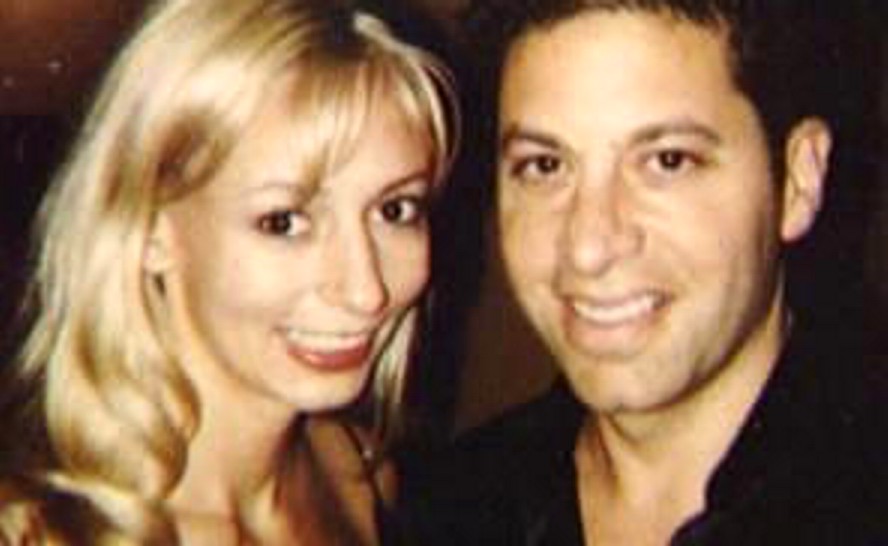
Wednesday, July 04, 2012
The Hands Of Time Video With Screenplay By Amanda Knox - A Confessional Obsession?
Posted by Fly By Night & Thundering
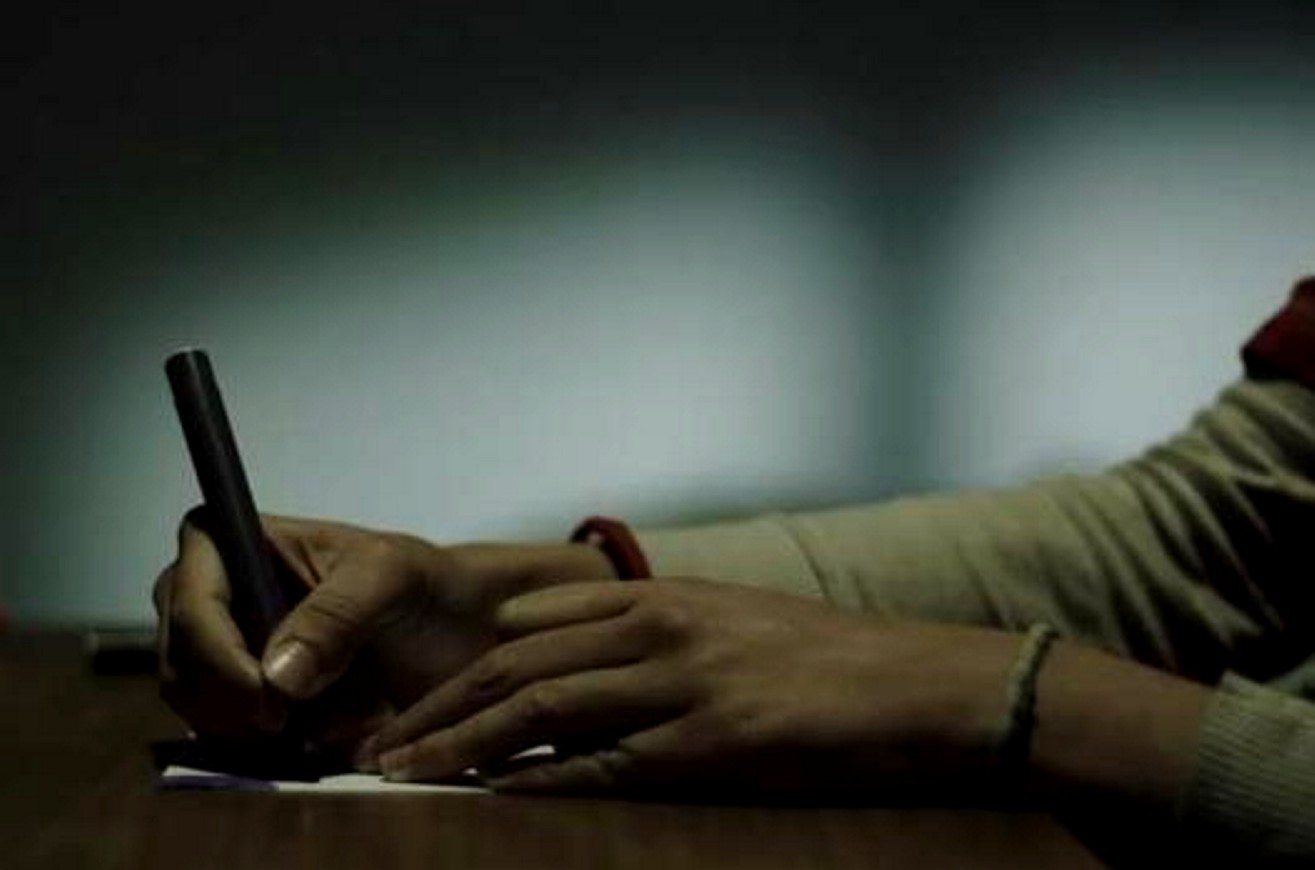
Amanda Knox rarely, if ever, mentions her “˜close friend’, murder victim Meredith Kercher. Perhaps out of her self-proclaimed desire to “˜move on with her life’.
So the recent Hands of Time (H.O.T.) music video The Mistral Blows which was posted on YouTube with a screenplay attributed to the Seattle native is nothing if not astonishing.
Whilst there is some discussion as to whether Amanda Knox wrote the entire screenplay, or a section of it, or whether the screenplay was created through a merging of several versions, the screenplay is clearly attributed to her in the credits that appear on the video.
Crediting Amanda Knox with the screenplay is repeatedly emphasized by H.O.T. themselves who posted multiple Twitter entries:
And this screenplay does Amanda Knox and her claims of innocence in the brutal murder of Meredith Kercher no favours at all.
Although provisionally “˜acquitted’ at the trial of second instance, Amanda Knox still stands accused of a capital crime, aspects of which she seems compelled to continue to portray in her various writings.
The hapless band H.O.T. might be well-advised to disassociate themselves from this endeavour and drop the video like a hot potato. The more-so as they have already burnt their fingers, tampering with the so-far elusive Brand Knox, finding themselves “˜forced to remove [clips of Knox dancing in Capanne] from the file, after a sudden, unexpected and “very strange” last-minute opposition from Amanda’s entourage.’
They state with a hint of bitterness:
The result? A compromise. The image of Knox dancing with carefree abandon in Capanne Prison (easily retrieved from other internet sites) remains, but is obliterated by a large “˜censored’ notice.
The reasons to attempt to disappear this video or, at the very least, any identifiable links with Knox, are abundantly clear to anyone having followed this dreadful case over the last four and a half years.
1) The video is riddled with allusions to the crime itself and features an easily-identifiable Amanda Knox as “˜heroine’ or “˜victim’ as she may now prefer to be seen and depending on how you look at it.
2) Any pre-book-release publicity will potentially devalue the carefully branded and preserved Amanda Knox product.
A cursory look at the video demonstrates the depraved audacity of the writer, a person who simultaneously insists she was found innocent of the crime of murder and of which she still stands accused.
The video features a Knox look-alike ““ recognizable by her clothing - in a prison-cum-house of horrors.
It opens with the heroine sitting down, colouring pictures in a prison cell. Amanda Knox was reported to spend time colouring pictures of her hands whilst in prison.
From there she leaves the cell and embarks on a journey through a range of horrifying experiences, until she finally flees the house but not the prison to which she is eternally condemned.
As she runs through the house of horrors she encounters:
1) Ghost-like figures lurching out at her hinting at the night of Halloween before the murder and the ghouls and demons of the house of horrors both in which the crime took place and in which she is forever imprisoned.
2) A tall, faceless black-haired figure dressed in black carrying an umbrella resembling Meredith Kercher dressed as a vampire on her last night alive, the red belt reminiscent of the fake costume blood and the actual blood spilled the night of the murder.
3) A faceless butcher figure dressed in a blood-stained apron holding a knife, who hands her a maggot-infested apple, reminiscent of the photograph of co-accused Raffaele Sollecito as posted on his Facebook page. The apple is suggestive of the poisoned apple offered by the witch to the innocent Snow White ““
4) Or a subliminal suggestion of Raffaele’s guilt in handing her the infested and poisonous apple “¦.. Remember: she claimed Raffaele may have pressed the murder knife with Meredith’s DNA into her hand whilst she was sleeping.
5) A figure tied to a chair covered in a red cloth hinting of the pools of blood and of Meredith unable to move to defend herself. As she reaches out to lift the red cloth the bound figure screams, sending her running out down staircases and steps and out of the house.
In the same way, witness Nora Cappezzali heard Meredith’s desperate, blood-curdling scream, followed shortly afterwards by running footsteps out of the house of horrors and onto the steel staircase near her home.
The video ends with the Knox look-alike remaining in prison. Both real and imagined.
H.O.T. suggest that the video and screenplay are a means of documenting the tale of the events in Perugia and, of course, Amanda Knox hopes to chronicle the nightmare in which she “˜innocently’ found herself. In so doing, she inadvertently describes the crime and the images, sounds and memories that will seemingly not leave her alone.
Not only are there many references to the crime, but there seems as well a clear jealous obsession with Meredith, given the numerous references and comparisons to Kristian Leontiou’s video Some Say in which Meredith hauntingly starred.
The Knox look-alike emulates Meredith from the Some Say video both in her dress and appearance as well as in her actions. She descends an old staircase, appears in doorways and through arches reminding us of the shots of Meredith and the church of the “˜Some Say’ video.
Emulation is a form of envy. Guilty or innocent, it seems Knox cannot exorcise her memories of the crime, and remains compelled to depict it in screenplays and short stories. Knox is seemingly still jealous of Meredith which had proved her original undoing. Here, in a bizarre reversal of reality, Meredith becomes the foreboding, frightening presence, whereas Knox is the shocked and terrified victim.
At a time when a tough Galati appeal to the Supreme Court and a $4 million book deal are on the table, the memory of Meredith and the crime seem to haunt and obsess Amanda Knox who may reveal a deep-seated need to confess. But while still accused, Amanda Knox cannot afford to engage in such obsessive, confessional activity.
Could this prove to be her final undoing?
Wednesday, May 09, 2012
An Associate Of Knox PR Heavy David Marriot Has Been Bullying Meredith’s Father Online
Posted by Glinda The Good

Yet another example of Curt Knox’s abusive public relations campaign at work.
We have long heard that the PR run for Curt Knox by David Marriott in Seattle controls all the pro-Knox anti-Italy message everywhere. David Marriott unwisely claimed this, in fact, right after Amanda Knox returned to Seattle. See here.
The PR is said to abuse reporters who dont go along, reward those that do, and fan out nasty commenters around the web to post selling points under various false names. It presumably does that to make the movement look spontaneous and big. An expanding but questionable technique which goes by the name astroturfing.
Every month more evidence piles up, suggesting that online comment threads and forums are being hijacked by people who aren’t what they seem.
The anonymity of the web gives companies and governments golden opportunities to run astroturf operations: fake grassroots campaigns that create the impression that large numbers of people are demanding or opposing particular policies. This deception is most likely to occur where the interests of companies or governments come into conflict with the interests of the public. For example, there’s a long history of tobacco companies creating astroturf groups to fight attempts to regulate them.
After I wrote about online astroturfing in December, I was contacted by a whistleblower. He was part of a commercial team employed to infest internet forums and comment threads on behalf of corporate clients, promoting their causes and arguing with anyone who opposed them.
Like the other members of the team, he posed as a disinterested member of the public. Or, to be more accurate, as a crowd of disinterested members of the public: he used 70 personas, both to avoid detection and to create the impression there was widespread support for his pro-corporate arguments. I’ll reveal more about what he told me when I’ve finished the investigation I’m working on.
The Knox PR astroturfing operation now has Meredith’s father John Kercher and his fine new book in its crosshairs, and for some days it has been raining contemptuous abuse. .
Officialdom in Perugia and Rome and the Italian Supreme Court all seem to know that the Knox-Mellases KNEW Amanda Knox was involved in the crime against Meredith almost as soon as they arrived in Perugia, and that they have been trying to cover that up ever since.
The PR scheme had already swung into operation by then, but the Knox-Mellases made the fateful choice to stick with it regardless, instead of maybe more wisely switching off the PR and turning to a good American lawyer to spread the word instead. Curt Knox recently claimed, before Amanda’s “innocent” persona started to implode, that using PR was one of the best choices he ever made.
This image above is of Seth Chandler, the managing director of Axolotl AB, a public relations firm linked to David Marriott’s which does the usual advertising, copy doctoring, social media campaigning, and so on. The image was captured online before it was hurriedly disappeared.
Seth appears to be the same chap caught red-handed the other day propagating the all-too-familiar FOA selling points while sliming the family of Meredith, who is the real victim here. Under an article on Worldcrunch which reported the imminent release of John Kercher’s book “Meredith” Seth Chandler was observed repeatedly posting that John Kercher (and others there trying to explain the truth) should simply STFU..
With only a couple of exceptions, real names of identifiable people are not used by the PR. We’ve seen them, we’ve read them, but this appears to be only the second time (after “Bruce Fisher of New York”) that one of the anonymous PR operatives/contractors has been exposed for what and where he is. Perhaps we might expect a few more.
For four years in the US and the UK, with big money at stake, the operatives have bashed Italy, the Italian justice system, Italian culture, and the Italian law enforcement agencies involved in the case. The operatives have slimed the Scientific Police, the prosecutor Mr Mignini, the prosecutor Ms Comodi, the British press, the Italian press, the Kerchers’ lawyer Mr Maresca, and all the prosecution witnesses. In various postings they have accused many of these people of crimes, an imprisonable felony in the US.
They have bashed the lay judges in the court because they wear their tricolour sashes routinely as a badge of office. They have claimed that this is an anti-American display. They have decried the Italian courtroom because behind the lead judge a crucifix hangs there.
The operatives have thrown mud at anyone they perceive as dangerously surfacing any hard truth about the case. Respected journalists have received exceptional abuse. Any perceived enemy not so much of Amanda Knox herself as the defense narrative of the murder and the legal processes can expect to get roughed up.
So it’s quite a game-changer when Seth Chandler, or “Seth C” as he now wants to be known, the managing director of Axolotl PR, is apparently caught red-handed telling John Kercher to STFU. Seth Chandler has claimed as he tried to wriggle off the hook that “no one paid” him to say STFU, and that anyway PRs would never say such a thing. Really? But the abuse was right there in his name.
Seth Chandler also works for Electrolux. Its competitors are are Dyson, and LG. I wouldn’t imagine that he employs the same tactics for firms, though I haven’t yet checked his Amazon customer reviews.
Shame on Seth Chandler - and on Curt Knox, whose vile temper reverberates throughout this case and some increasingly believe sent Amanda Knox over the top.
Tuesday, March 13, 2012
In Desperation A Council Of War? All Of The Sollecito Family Suddenly Hop On Flights To Seattle
Posted by Our Main Posters
What’s going on here?
Sollecito has been in Los Angeles working on a book with a shadow writer. His father has said very firmly several times that Sollecito and Amanda Knox are through. Finito.
But Italian media are suddenly reporting that Sollecito is hopping on a plane for Seattle. And that his family, seemingly in a panic, is high-tailing it after him.
Are both families really nervous that the two will get back together for better or (probably) worse? Or is this a council of war between the Sollecitos, Knoxes, and Mellases?
Actually, this meet-up is no surprise at all to the close case watchers in Italy. They were wondering how else the two families and their loose-cannon kids could make it through the minefields ahead. They seem to be facing a five-problem agenda.
Problem One For Discussion
The most immediate problem for the two families is described in the box at the top of the page here. Curt Knox and Edda Mellas are headed for a civil trial brought by aggrieved police, seemingly without an ounce of proof on the family’s side other than any testimony from Amanda Knox herself under cross-examination (for the first time) on the witness stand.
Almost simultaneously the Sollecitos (five of them) are headed for a CRIMINAL trial for illegal release of evidence and attempted political interference which could eventually land them in prison. The two charges against them seem pretty cut and dried with hard evidence on film and audio tape to which they have not so far offered even a sliver of a rebuttal.
Problem Two For Discussion
The second problem is that officialdom in Rome and Perugia seem to almost universally believe that the two families have all along known that both of their kids were somehow involved in Meredith’s murder. Some of the suggestive evidence is out there in broad daylight and we suspect that prosecutors may be holding back more.
Contrary to the claims of Amanda Knox’s supporters that prosecutors maliciously threw the book at the defendants and their tribes to somehow save face, the truth is that prosecutors stopped short of taking all of the possible actions open to them.
For example they turned down an offer by Guede to testify fully at first trial (after which he was beaten up in prison and reduced to a jelly which must have pleased him no end) and they seem to know more than they are saying about hard drugs - Knox apparently had a cocaine dealer’s number in her mobile phone. Also they chose not to investigate any of the rumors and backstories in Seattle which US prosecutors might well have done.
In the Sollecito case they may have felt they had no choice but to proceed. The released evidence tape showing Meredith’s naked body was repeatedly broadcast nationally, and the Carabinieri and Rome police are both involved in the political meddling component. Bari prosecutors will of course be trying the case.
Problem Three For Discussion
The third problem is that Judge Hellman has done the families no favors. On the day after he issued his verdict he contradicted himself in an unhelpful way. Then he published an emotional report explaining the surprise outcome of the first appeal which is short on logic and correct law, and full of innuendo and bizarre intellectual leaps.
PMF and TJMK will be posting a careful translation of the Hellman report with a full analysis of its weaknesses soon.
Problem Four For Discussion
Chief Prosecutor Galati has already filed a formidable Supreme Court appeal against the first appeal outcome, which argues in part that (1) the scope of Hellman’s report was illegal overreach; and that (2) his appointing of the two independent DNA experts was more illegal overreach.
As it has done in many other cases in the past, the Supreme Court might send the outcome of the first appeal back to Perugia to be corrected just as soon as it reads that.
And if it reads further, it cannot help but note that Judge Hellman has brushed right by hundreds of questions that still remain open. The Supreme Court has ALREADY rejected Judge Hellman’s hypothesis that Rudy Guede broke in and attacked Meredith all by himself. It has sided with Judges Massei and Micheli that there were actually three perpetrators.
Problem Five For Discussion
The blockbuster book offers required to pay for all this new legal action seemed very short on due diligence in the context of the calunnia minefield that Italian law creates for writers and publishers. Did the writers and publishers even know about that?
Past explanations and alibis from Knox and Sollecito have repeatedly contradicted one another’s. At one point, each seemed to be accusing the other of the crime. At trial, Knox seemed to want to talk all the time, while Sollecito barely ever said a word. Now we are seeing the exact opposite. Sollecito seemingly cannot keep quiet to save himself, while Knox seems petrified and terminally tongue-tied.
Their books are going to need to be line-by-line supportive of one another, and they will be disasters if they rely on slamming Italian officials and moping (Knox’s apparent angle) or on denying all the hard evidence and moping (Sollecito’s apparent angle).
There will be cancellation clauses in the publishers’ fine print, and what they are we may all soon find out. From the two families’ point of view, this entire landscape must look very nasty and foreboding. An ill-advised legal and PR strategy has led them into this minefield.
Not surprising that they now find a sudden need to chat.




